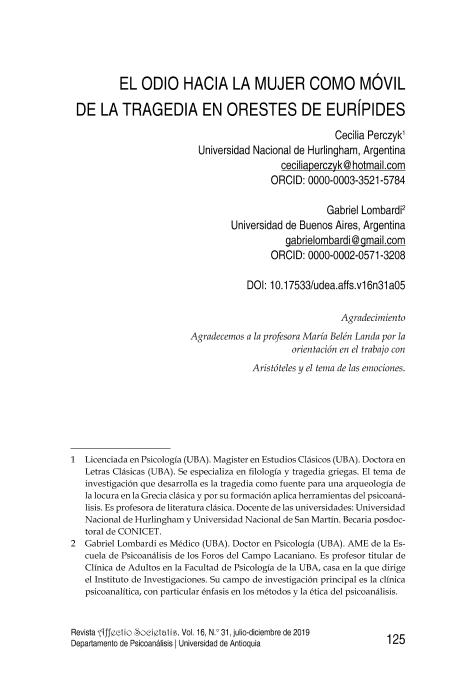Mostrar el registro sencillo del ítem
dc.contributor.author
Perczyk, Cecilia Josefina

dc.contributor.author
Lombardi, Gabriel

dc.date.available
2021-01-06T15:04:56Z
dc.date.issued
2019-03
dc.identifier.citation
Perczyk, Cecilia Josefina; Lombardi, Gabriel; El odio hacia la mujer como móvil de la tragedia en Orestes de Eurípides; Universidad de Antioquia; Affectio Societatis; 16; 31; 3-2019; 125-147
dc.identifier.uri
http://hdl.handle.net/11336/121605
dc.description.abstract
En la tragedia Orestes de Eurípides se representan los sucesos acontecidos en la ciudad de Argos luego del asesinato de Clitemnestra. El protagonista de la obra es el matricidaOrestes, a quien se lo muestra sumamente excitado en la planificación de un nuevocrimen, el de Helena y su hija Hermíone. En el presente trabajo nos proponemos analizar el odio a la mujer como el móvil de la trama desde la teoría psicoanalítica de orientación lacaniana. El desprecio se constituye como un antecedente de la acción trágica al trasladarse de Clitemnestra hacia Helena, figura emblemática de la mitología griega por ser considerada la mujer más hermosa.
dc.description.abstract
In Euripides’ tragedy Orestes are represented the events occurred in the city of Argos after the murder of Clytemnestra. The main character of the play is the matricide Orestes, who is displayed extremely excited in the planning of a new crime, the one of Helena and her daughter Hermione. This paper aims to analyze hatred towards the woman as motivation of the plot from the psychoanalytic theory of Lacanian orientation. Contempt becomes an antecedent of the tragic action by moving from Clytemnestra towards Helena, emblematic figure of Greek mythology for being considered as the most beautiful woman.
dc.description.abstract
La tragédie Oreste d’Euripide présente les événements qui ont eu lieu à Argos après le meurtre de Clytemnestre. Le protagoniste de l’œuvre est le matricide Oreste, qui est dépeint comme quelqu’un de très excité planifiant un nouveau crime, celui d’Hélène et de sa fille Hermione. Ce texte a pour but d’analyser la haine envers la femme en tant que mobile de la trame sous l’angle de la théorie psychanalytique à orientation lacanienne. Le mépris apparaît comme antécédent de l’action tragique puisqu’il passe de Clytemnestre à Hélène, figure emblématique de la mythologie grecque car considérée comme la plus belle femme.
dc.format
application/pdf
dc.language.iso
spa
dc.publisher
Universidad de Antioquia

dc.rights
info:eu-repo/semantics/openAccess
dc.rights.uri
https://creativecommons.org/licenses/by-nc-nd/2.5/ar/
dc.subject
EURÍPIDES
dc.subject
ORESTES
dc.subject
ODIO
dc.subject
MUJER
dc.subject.classification
Otras Psicología

dc.subject.classification
Psicología

dc.subject.classification
CIENCIAS SOCIALES

dc.title
El odio hacia la mujer como móvil de la tragedia en Orestes de Eurípides
dc.title
Hatred towards the woman as motivation of the tragedy in euripides’ orestes
dc.title
La haine envers la femme en tant que mobile dans oreste d’euripide
dc.type
info:eu-repo/semantics/article
dc.type
info:ar-repo/semantics/artículo
dc.type
info:eu-repo/semantics/publishedVersion
dc.date.updated
2020-12-21T17:23:37Z
dc.identifier.eissn
0123-8884
dc.journal.volume
16
dc.journal.number
31
dc.journal.pagination
125-147
dc.journal.pais
Colombia

dc.journal.ciudad
Medellín
dc.description.fil
Fil: Perczyk, Cecilia Josefina. Universidad Nacional de Hurlingham; Argentina. Universidad de Buenos Aires. Facultad de Psicología; Argentina. Consejo Nacional de Investigaciones Científicas y Técnicas; Argentina
dc.description.fil
Fil: Lombardi, Gabriel. Universidad de Buenos Aires. Facultad de Psicología; Argentina
dc.journal.title
Affectio Societatis
dc.relation.alternativeid
info:eu-repo/semantics/altIdentifier/doi/http://dx.doi.org/10.17533/udea.affs.v16n31a05
dc.relation.alternativeid
info:eu-repo/semantics/altIdentifier/url/https://revistas.udea.edu.co/index.php/affectiosocietatis/article/view/339123
Archivos asociados
